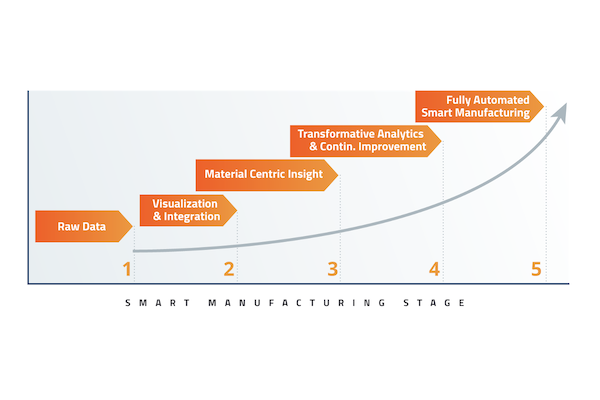
Industry 4.0, Smart Manufacturing, digital transformation — these terms all refer to the application of computer-based digital technologies, interconnectivity, data analytics, and automation to transform what’s possible for manufacturing, with benefits including improved quality, yield, safety, and efficiency.
Many manufacturers have made the digital transformation, but others may find it easy to be overwhelmed amidst all the hype. Luckily, there are some tangible, practical steps that can take any organization from their current level of performance to the next generation of Smart Manufacturing.
5 Steps To Becoming A Smart Manufacturing Firm
To reach Industry 4.0 Smart Manufacturing status, every manufacturer must go through these 5 steps:
- Data Capture: The first step toward becoming a Smart Manufacturer is the collection of raw data. This includes data from IoT and IIoT devices, HMIs, ERPs, CRM, and manual data captures, gathered end-to-end across your manufacturing operations — data about raw materials, processing, manufacturing, delivery & distribution, transportation, and at the consumer level. Seeing all your data is crucial, and puts you ahead of some competitors, but at this stage it’s almost certainly still on a wide variety of screens and in different silos, and not yet being leveraged in the most useful possible way for your organization.
- Visualization and Integration: The second step to be considered a Smart Manufacturing firm involves access to wide visibility, and the contextualization and centralization of your data. Existing sensors continue to collect data from the first step, only now they also aggregate and securely send the data to a common location, often the cloud. All your data becomes available on one screen, across multiple facilities — often a revolutionary moment for production teams. Data scientists are empowered. Notifications bring problems to your attention. Risk mitigation and yield improvements begin.
- Material-Centric Insight: The third step to Smart Manufacturing status is to enable a material-centric view of operations, with the key outcome of being able to identify previously unseen correlations, even root issues, from your supply chain through the internal manufacturing process and outward towards the end-user. To reach this step, your Industry 4.0 platform will require advanced artificial intelligence (AI) and machine learning (ML) capabilities that will enable cause and effect determinations — which is what ultimately leads to the most useful predictions and suggestions.
- Transformational Intelligence: The fourth step on the path to Smart Manufacturing builds on the previous steps, utilizing all their efforts to being supplying transformational intelligence to manufacturing organizations. You have your data, it’s integrated, visible, and processed by AI/ML that can truly make sense of it. Data points from suppliers through customers are processed and related to your KPIs. Now, you will be able to rapidly spot operational anomalies, addressing problems much earlier in the process, and uncover opportunities for improvement in your manufacturing process and supply chain — saving you both time and money. The data you receive is transformed, and you have an instant, intelligent, end-to-end view of operations.
- Industry 4.0 Smart Manufacturing: The fifth and final step to Smart Manufacturing, along with all the ongoing Industry 4.0 benefits it provides. By this stage, your organization has undergone a true transformation to create the most efficient, safest manufacturing line in history. With fully autonomous Smart Manufacturing, your manufacturing process now includes traceability from raw materials to product delivery, optimized supply chains, continuous improvement, and fully transparent, realtime, contextualized data. The results are truly revolutionary, establishing users as more competitive, more profitable market leaders.
Smart Manufacturing is quickly growing in this fourth industrial revolution, and the benefits are undeniable. Even if you’re using a legacy system and are accustomed to certain methods, following these 5 steps will take you to Smart Manufacturing status sooner, and easier than you think.
Smart Manufacturing - The Journey Begins Here
The path to Smart Manufacturing is different for every enterprise, but the direction is the same –– towards modern, optimized manufacturing. ThinkIQ supplies Transformational Intelligence, taking manufacturing businesses through the 5 stages needed to reach fully automated Smart Manufacturing status.
This Smart Manufacturing revolution goes far beyond analytics. While ERP, MES, MOM and other manufacturing analytics were a first step to connecting data, they do not create truly connected, truly maximized Industry 4.0 manufacturing systems. In fact, until recently no platform has implemented traceability and supply chain data that creates proactive, actionable end-to-end data insights with the petabytes of manufacturing data created daily.
ThinkIQ’s 5-stage solutions roadmap combines the best of supply chain data analytics, traceability, and manufacturing analytics into the next generation manufacturing data platform, offering valuable improvements to manufacturers at each stage, and creating a true transformation to Industry 4.0 Smart Manufacturing.
Every great journey begins with a single step — take the first one today by contacting a ThinkIQ expert to learn more about our 5 stage path to becoming a Smart Manufacturing enterprise. You can also download our eBook, “An Evaluation Guide to Industry 4.0 and Smart Manufacturing,” to help get you started.


